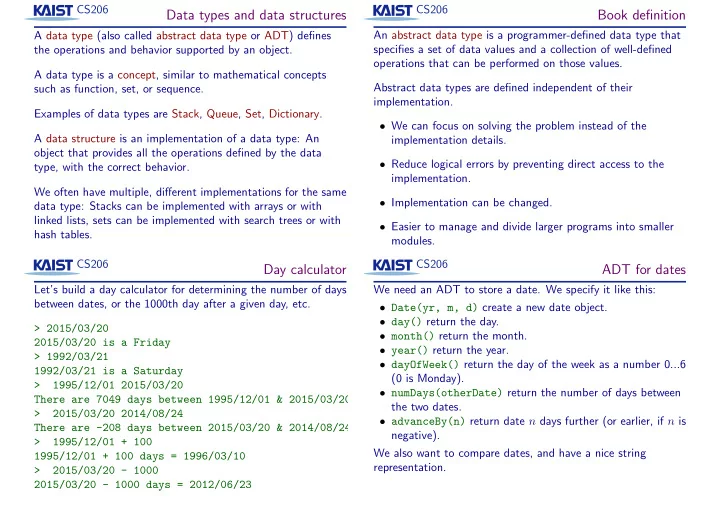

CS206 CS206 Data types and data structures Book definition An abstract data type is a programmer-defined data type that A data type (also called abstract data type or ADT) defines specifies a set of data values and a collection of well-defined the operations and behavior supported by an object. operations that can be performed on those values. A data type is a concept, similar to mathematical concepts Abstract data types are defined independent of their such as function, set, or sequence. implementation. Examples of data types are Stack, Queue, Set, Dictionary. • We can focus on solving the problem instead of the A data structure is an implementation of a data type: An implementation details. object that provides all the operations defined by the data • Reduce logical errors by preventing direct access to the type, with the correct behavior. implementation. We often have multiple, different implementations for the same • Implementation can be changed. data type: Stacks can be implemented with arrays or with linked lists, sets can be implemented with search trees or with • Easier to manage and divide larger programs into smaller hash tables. modules. CS206 CS206 Day calculator ADT for dates Let’s build a day calculator for determining the number of days We need an ADT to store a date. We specify it like this: between dates, or the 1000th day after a given day, etc. • Date(yr, m, d) create a new date object. • day() return the day. > 2015/03/20 • month() return the month. 2015/03/20 is a Friday • year() return the year. > 1992/03/21 • dayOfWeek() return the day of the week as a number 0...6 1992/03/21 is a Saturday (0 is Monday). > 1995/12/01 2015/03/20 • numDays(otherDate) return the number of days between There are 7049 days between 1995/12/01 & 2015/03/20 the two dates. > 2015/03/20 2014/08/24 • advanceBy(n) return date n days further (or earlier, if n is There are -208 days between 2015/03/20 & 2014/08/24 negative). > 1995/12/01 + 100 We also want to compare dates, and have a nice string 1995/12/01 + 100 days = 1996/03/10 representation. > 2015/03/20 - 1000 2015/03/20 - 1000 days = 2012/06/23
CS206 CS206 Client code Implementing the Date class Since we have a fully specified Date ADT, we can start by class Date(): writing the client code. def __init__(self, year, month, day): self._year = year >>> from date import Date self._month = month >>> a = Date(1996, 9, 3) self._day = day >>> b = Date(2015, 9, 8) >>> a.numDays(b) For the dayOfWeek , numDays , and advanceBy methods we 6944 need to convert to and from Julian day number. >>> print(a.advanceBy(7000)) def dayOfWeek(self): 2015/11/03 jday = self._toJulianDay() return jday % 7 def numDays(self, otherDate): return otherDate._toJulianDay() - self._toJulianDay() CS206 CS206 Another implementation? Equality and Ordering Imagine an application, where we need to store millions of We want to compare dates using all the standard operators: Date objects. == , < , <= , >= , > , != . We should make Date as small as possible—ideally store only def __eq__(self, rhs): return self._jday == rhs._jday a single number. class Date(): def __lt__(self, rhs): def __init__(self, year, month, day): return self._jday < rhs._jday self._jday = _toJulianDay(year, month, day) def __le__(self, rhs): The methods year , month , day get harder now, but numDays return self._jday <= rhs._jday and dayOfWeek get easier. . . def dayOfWeek(self): return self._jday % 7 def numDays(self, otherDate): return otherDate._jday - self._jday
CS206 CS206 Invalid dates Handling invalid dates Our class does not recognize invalid dates: Recognizing invalid dates is easy: convert to day number and back—if it’s not equal, it’s invalid. > 2015/02/29 2015/02/29 is a Sunday But how to report the error? The __init__ method must > 2015/09/31 return a Date object! 2015/09/31 is a Thursday > 2015/13/00 Solution: raise an exception 2015/13/00 is a Thursday def __init__(self, year, month, day): > 2015/13/01 - 1 jday = _toJulianDay(year, month, day) 2015/13/01 - 1 days = 2015/12/31 y, m, d = _jdayToYMD(jday) > 2015/12/00 + 1 if y != year or m != month or d != day: 2015/12/00 + 1 days = 2015/12/01 raise ValueError("Invalid Gregorian date") > 2015/02/29 2015/03/01 self._jday = jday There are 0 days between 2015/02/29 and 2015/03/01 But now the program crashes when we use an invalid date. . . CS206 CS206 Catching exceptions Exceptions simplify our error handling We need to catch the exception and report the error to the We can now also handle the incorrect date formats using user: exceptions. This simplifies the entire days program: We no longer need to s = input("> ") check the result of get_date every time we call it. f = s.split() try: def show_weekday(s): if len(f) == 0: day = get_date(s) return print(day, "is a", dayNames[day.dayOfWeek()]) elif len(f) == 1: show_weekday(f[0]) def show_difference(s1, s2): elif len(f) == 2: day1 = get_date(s1) show_difference(f[0], f[1]) day2 = get_date(s2) # omitted print("There are", day1.numDays(day2), except ValueError as e: "days between", day1, "and", day2) print(e)
Recommend
More recommend